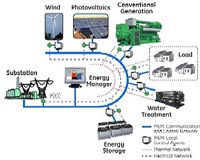 |
Washington DC (SPX) May 27, 2011 A new, free software tool from the National Institute of Standards and Technology (NIST) could prove to be a breath of fresh air for architects and designers of ventilation systems for "green" commercial buildings. With the Climate Suitability Tool,* building design teams can evaluate whether the local climate is suitable for cooling a prospective building with natural ventilation or requires a hybrid system that supplies supplemental cooling capacity. The tool is based on a model of the heat-related characteristics of a building configured to take full advantage of ambient climate conditions and natural air movement. It incorporates an algorithm-or problem-solving procedure-that crunches hourly weather data (downloaded from annual datasets for U.S. localities) and uses standardized criteria for rating the comfort of building occupants. "We think this tool will be useful during the early stages of design, when decisions on the form of a building and its components are being made," explains NIST mechanical engineer Steven Emmerich. "It provides estimates of ventilation rates for preliminary design calculations. You can approximate how many air changes per hour will be necessary to offset heat gains due to the occupants, equipment and lighting so that comfortable conditions are maintained." The effects of direct natural ventilation and a nighttime cooling procedure are assessed using a method devised by James Axley, Yale University professor of architecture and engineering. When the outdoor temperature is below an accepted threshold, direct ventilation through open windows and by other means can deliver the cooling to maintain the comfort zone. When the outdoor temperature exceeds the threshold during the day but drops below it after sunset, the cooler nightime air can dilute heat gained during the day and build a reserve of cooling potential for the day to come. Results include an estimate of the total number and percentage of hours that direct ventilation would be effective over the total for the year; the percentage of hours for which ambient conditions would be too cold, hot, or humid for direct ventilation; the total number of days warranting nighttime cooling; and the estimated percentage of days for which nighttime cooling would be effective. In a recently published article, Emmerich, Axley, and NIST's Brian Polidoro describe the capabilities of the new sustainability analysis tool, and present results of analyses of different scenarios in four U.S. cities representing a wide range of climates: Kansas City, Los Angeles, Miami, and Phoenix. They also evaluate the impact of an adaptive thermal comfort standard for buildings, issued by the American Society for Heating, Refrigeration, and Air-Conditioning Engineers (ASHRAE). The ASHRAE standard (55-2010) includes an option for specifying a range of temperatures as opposed to setting fixed maximum outdoor temperature at which occupants will become increasingly uncomfortable. Studies have found that occupants of naturally ventilated buildings tolerate a wider range of temperature than do people in air-conditioned structures. The researchers concluded that in cities with dry climates, such as Phoenix and Los Angeles, the adaptive thermal comfort option increases the effectiveness of natural cooling. Though not specified in the standard, humidity levels should be carefully considered when evaluating cooling and ventilation options, they recommended.
Share This Article With Planet Earth
Related Links National Institute of Standards and Technology (NIST) Powering The World in the 21st Century at Energy-Daily.com
 LockMart's Microgrid Development Center Enhanced With Five Times Greater Capability
LockMart's Microgrid Development Center Enhanced With Five Times Greater CapabilityDallas TX (SPX) May 27, 2011 Lockheed Martin Intelligent Microgrid Solutions group recently upgraded its Microgrid Development Center (MDC) to increase its load capacity and power handling from 100 kilowatts to 500 kilowatts and energy storage from 4 kilowatt hours to 20 kilowatt hours. Now, the intelligent microgrid research and development facility, located in Dallas, has augmented capabilities that allow it to emul ... read more |
|
| The content herein, unless otherwise known to be public domain, are Copyright 1995-2010 - SpaceDaily. AFP and UPI Wire Stories are copyright Agence France-Presse and United Press International. ESA Portal Reports are copyright European Space Agency. All NASA sourced material is public domain. Additional copyrights may apply in whole or part to other bona fide parties. Advertising does not imply endorsement,agreement or approval of any opinions, statements or information provided by SpaceDaily on any Web page published or hosted by SpaceDaily. Privacy Statement |